BTEC Level 3 Diploma International Business Report Analysis
VerifiedAdded on 2020/07/22
|11
|3285
|101
Report
AI Summary
This report provides a comprehensive overview of international business, examining the operations of McDonald's within the global environment. It details the international business environment, including factors such as economies of scale and the impact of free trade. The report describes mechanisms regulating international trade, explores how cultural and environmental factors influence businesses operating internationally, and analyzes the effects of the monetary environment. It identifies the reasons why businesses expand internationally and explains the business strategies employed in these ventures. The report further delves into taxation policies, employment legislation, and the challenges faced by businesses in new markets, providing a detailed analysis of various aspects of international business operations and their implications for business performance. The report uses McDonald's as a case study to illustrate key concepts.
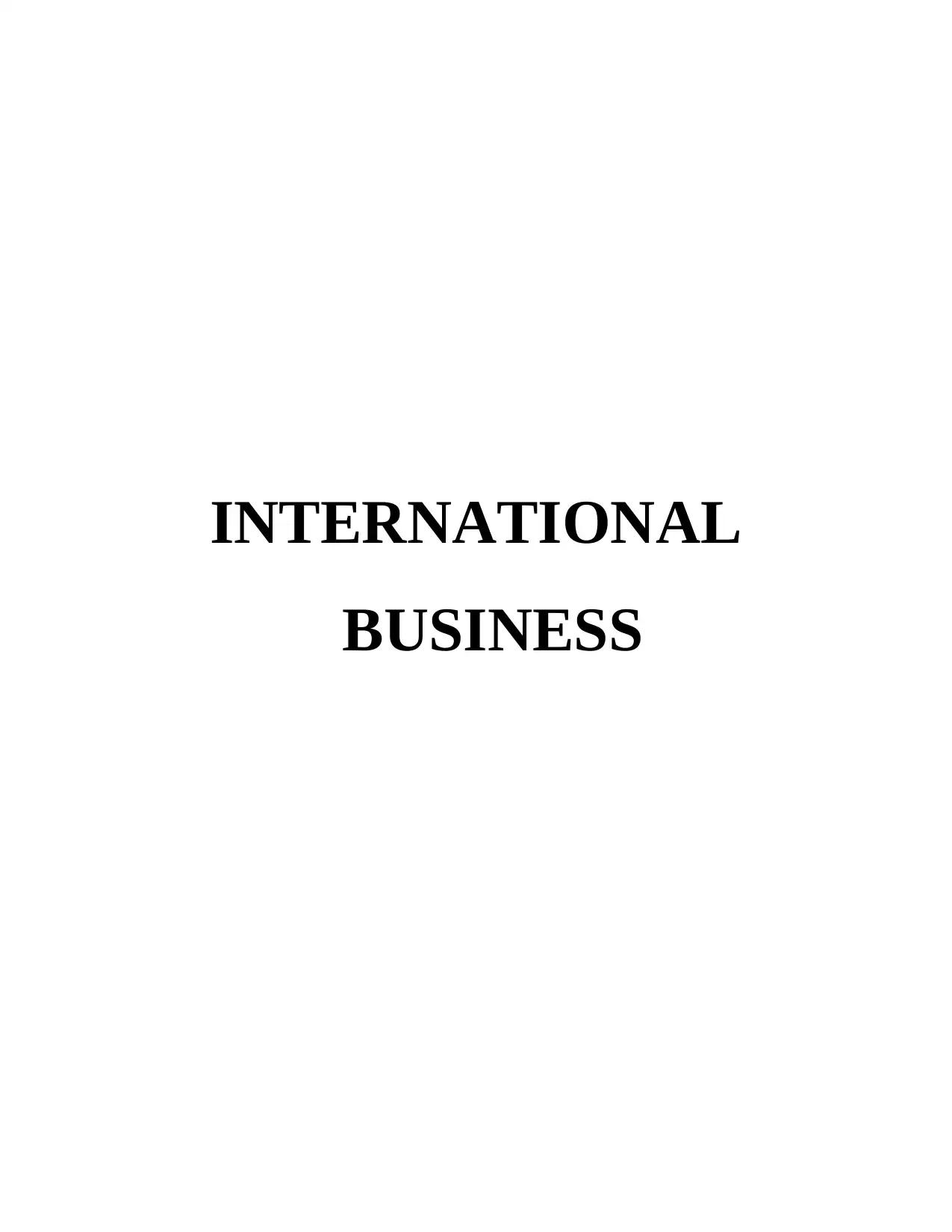
INTERNATIONAL
BUSINESS
BUSINESS
Paraphrase This Document
Need a fresh take? Get an instant paraphrase of this document with our AI Paraphraser
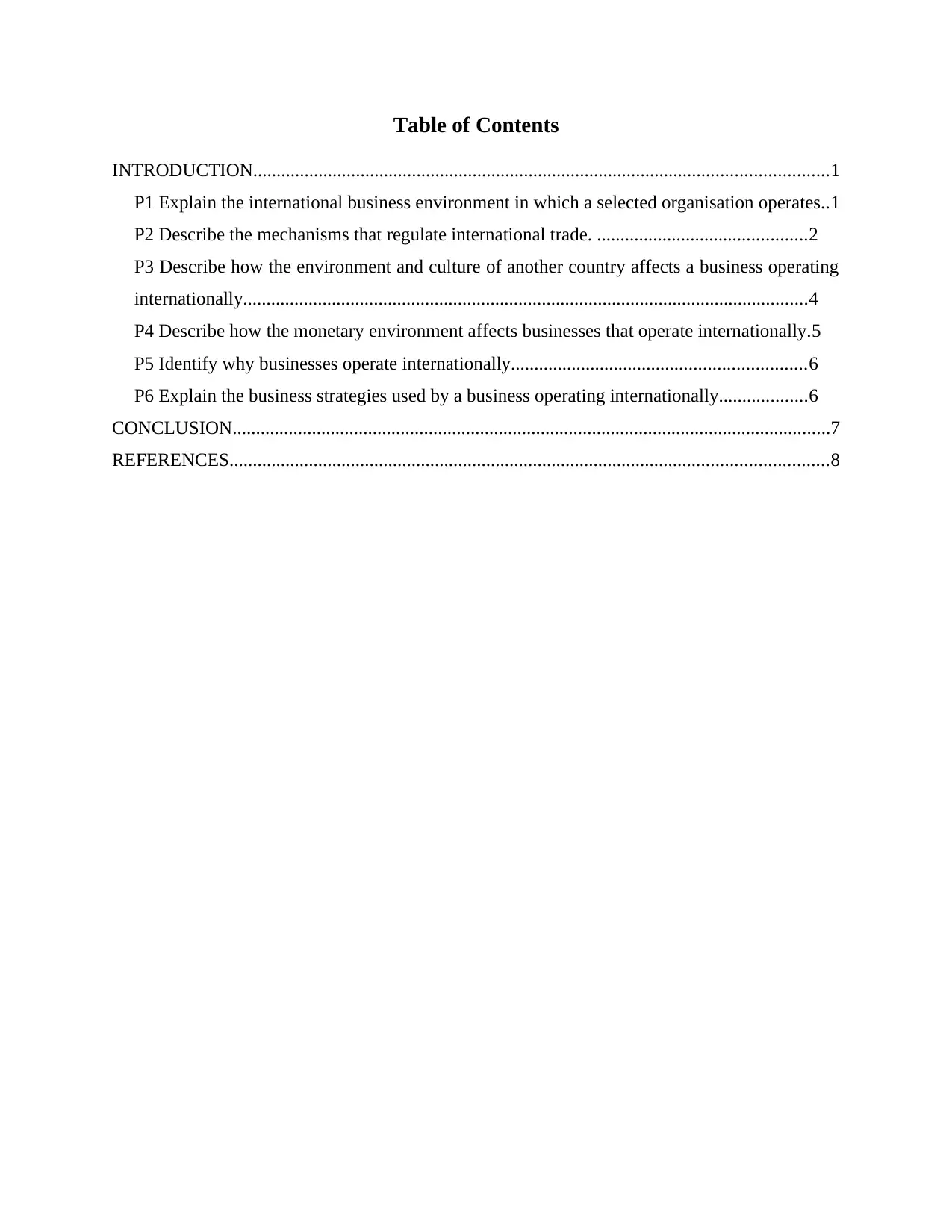
Table of Contents
INTRODUCTION...........................................................................................................................1
P1 Explain the international business environment in which a selected organisation operates..1
P2 Describe the mechanisms that regulate international trade. .............................................2
P3 Describe how the environment and culture of another country affects a business operating
internationally.........................................................................................................................4
P4 Describe how the monetary environment affects businesses that operate internationally.5
P5 Identify why businesses operate internationally...............................................................6
P6 Explain the business strategies used by a business operating internationally...................6
CONCLUSION................................................................................................................................7
REFERENCES................................................................................................................................8
INTRODUCTION...........................................................................................................................1
P1 Explain the international business environment in which a selected organisation operates..1
P2 Describe the mechanisms that regulate international trade. .............................................2
P3 Describe how the environment and culture of another country affects a business operating
internationally.........................................................................................................................4
P4 Describe how the monetary environment affects businesses that operate internationally.5
P5 Identify why businesses operate internationally...............................................................6
P6 Explain the business strategies used by a business operating internationally...................6
CONCLUSION................................................................................................................................7
REFERENCES................................................................................................................................8
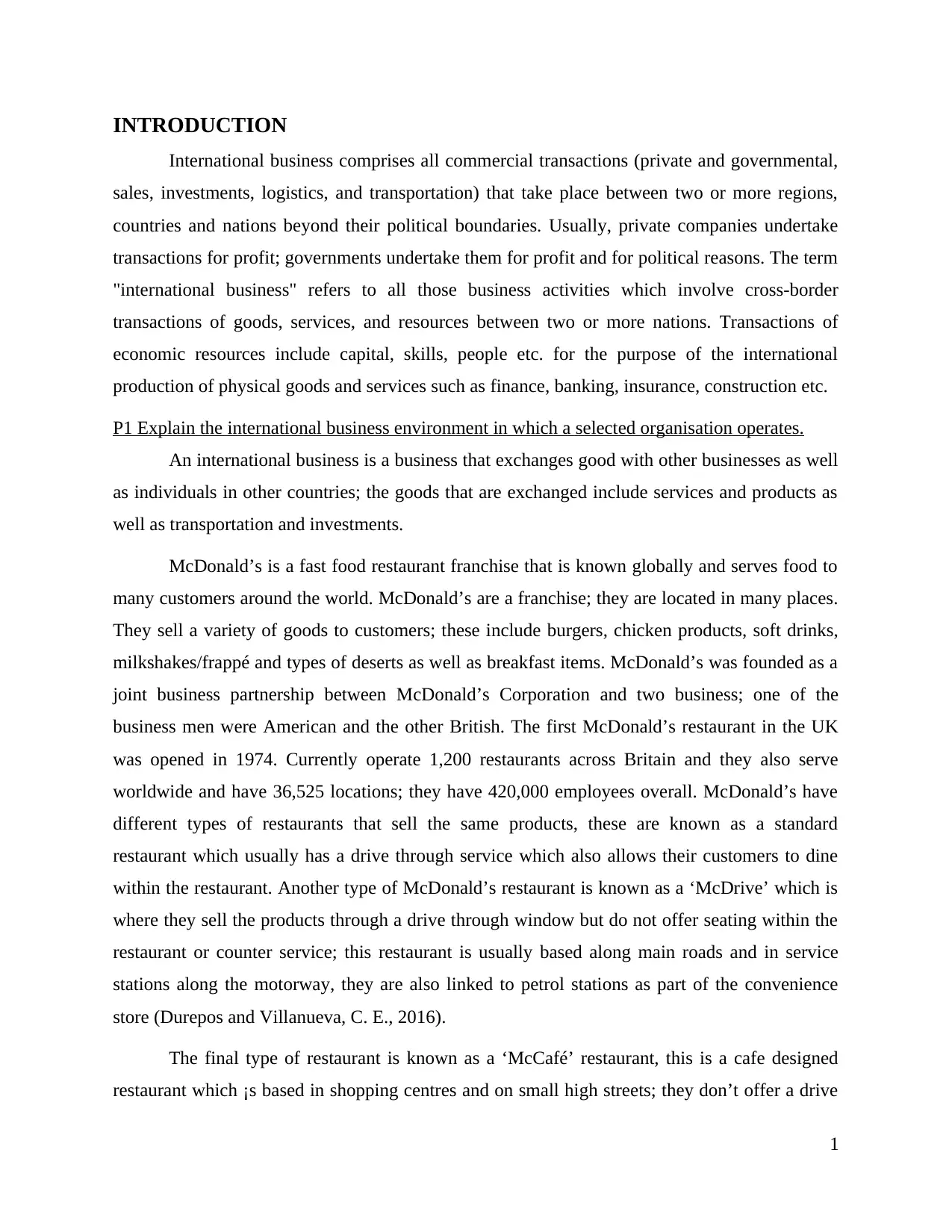
INTRODUCTION
International business comprises all commercial transactions (private and governmental,
sales, investments, logistics, and transportation) that take place between two or more regions,
countries and nations beyond their political boundaries. Usually, private companies undertake
transactions for profit; governments undertake them for profit and for political reasons. The term
"international business" refers to all those business activities which involve cross-border
transactions of goods, services, and resources between two or more nations. Transactions of
economic resources include capital, skills, people etc. for the purpose of the international
production of physical goods and services such as finance, banking, insurance, construction etc.
P1 Explain the international business environment in which a selected organisation operates.
An international business is a business that exchanges good with other businesses as well
as individuals in other countries; the goods that are exchanged include services and products as
well as transportation and investments.
McDonald’s is a fast food restaurant franchise that is known globally and serves food to
many customers around the world. McDonald’s are a franchise; they are located in many places.
They sell a variety of goods to customers; these include burgers, chicken products, soft drinks,
milkshakes/frappé and types of deserts as well as breakfast items. McDonald’s was founded as a
joint business partnership between McDonald’s Corporation and two business; one of the
business men were American and the other British. The first McDonald’s restaurant in the UK
was opened in 1974. Currently operate 1,200 restaurants across Britain and they also serve
worldwide and have 36,525 locations; they have 420,000 employees overall. McDonald’s have
different types of restaurants that sell the same products, these are known as a standard
restaurant which usually has a drive through service which also allows their customers to dine
within the restaurant. Another type of McDonald’s restaurant is known as a ‘McDrive’ which is
where they sell the products through a drive through window but do not offer seating within the
restaurant or counter service; this restaurant is usually based along main roads and in service
stations along the motorway, they are also linked to petrol stations as part of the convenience
store (Durepos and Villanueva, C. E., 2016).
The final type of restaurant is known as a ‘McCafé’ restaurant, this is a cafe designed
restaurant which ¡s based in shopping centres and on small high streets; they don’t offer a drive
1
International business comprises all commercial transactions (private and governmental,
sales, investments, logistics, and transportation) that take place between two or more regions,
countries and nations beyond their political boundaries. Usually, private companies undertake
transactions for profit; governments undertake them for profit and for political reasons. The term
"international business" refers to all those business activities which involve cross-border
transactions of goods, services, and resources between two or more nations. Transactions of
economic resources include capital, skills, people etc. for the purpose of the international
production of physical goods and services such as finance, banking, insurance, construction etc.
P1 Explain the international business environment in which a selected organisation operates.
An international business is a business that exchanges good with other businesses as well
as individuals in other countries; the goods that are exchanged include services and products as
well as transportation and investments.
McDonald’s is a fast food restaurant franchise that is known globally and serves food to
many customers around the world. McDonald’s are a franchise; they are located in many places.
They sell a variety of goods to customers; these include burgers, chicken products, soft drinks,
milkshakes/frappé and types of deserts as well as breakfast items. McDonald’s was founded as a
joint business partnership between McDonald’s Corporation and two business; one of the
business men were American and the other British. The first McDonald’s restaurant in the UK
was opened in 1974. Currently operate 1,200 restaurants across Britain and they also serve
worldwide and have 36,525 locations; they have 420,000 employees overall. McDonald’s have
different types of restaurants that sell the same products, these are known as a standard
restaurant which usually has a drive through service which also allows their customers to dine
within the restaurant. Another type of McDonald’s restaurant is known as a ‘McDrive’ which is
where they sell the products through a drive through window but do not offer seating within the
restaurant or counter service; this restaurant is usually based along main roads and in service
stations along the motorway, they are also linked to petrol stations as part of the convenience
store (Durepos and Villanueva, C. E., 2016).
The final type of restaurant is known as a ‘McCafé’ restaurant, this is a cafe designed
restaurant which ¡s based in shopping centres and on small high streets; they don’t offer a drive
1
⊘ This is a preview!⊘
Do you want full access?
Subscribe today to unlock all pages.

Trusted by 1+ million students worldwide
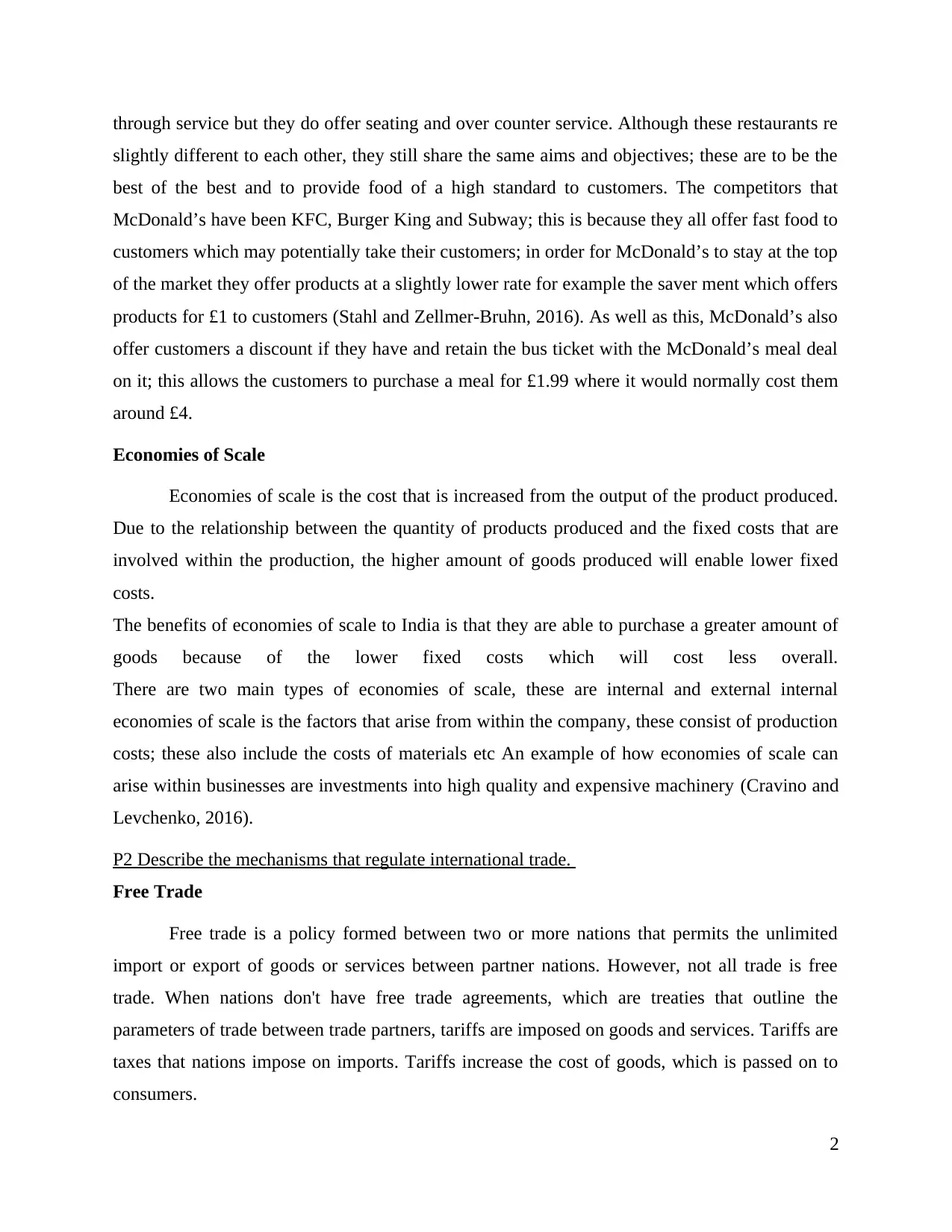
through service but they do offer seating and over counter service. Although these restaurants re
slightly different to each other, they still share the same aims and objectives; these are to be the
best of the best and to provide food of a high standard to customers. The competitors that
McDonald’s have been KFC, Burger King and Subway; this is because they all offer fast food to
customers which may potentially take their customers; in order for McDonald’s to stay at the top
of the market they offer products at a slightly lower rate for example the saver ment which offers
products for £1 to customers (Stahl and Zellmer-Bruhn, 2016). As well as this, McDonald’s also
offer customers a discount if they have and retain the bus ticket with the McDonald’s meal deal
on it; this allows the customers to purchase a meal for £1.99 where it would normally cost them
around £4.
Economies of Scale
Economies of scale is the cost that is increased from the output of the product produced.
Due to the relationship between the quantity of products produced and the fixed costs that are
involved within the production, the higher amount of goods produced will enable lower fixed
costs.
The benefits of economies of scale to India is that they are able to purchase a greater amount of
goods because of the lower fixed costs which will cost less overall.
There are two main types of economies of scale, these are internal and external internal
economies of scale is the factors that arise from within the company, these consist of production
costs; these also include the costs of materials etc An example of how economies of scale can
arise within businesses are investments into high quality and expensive machinery (Cravino and
Levchenko, 2016).
P2 Describe the mechanisms that regulate international trade.
Free Trade
Free trade is a policy formed between two or more nations that permits the unlimited
import or export of goods or services between partner nations. However, not all trade is free
trade. When nations don't have free trade agreements, which are treaties that outline the
parameters of trade between trade partners, tariffs are imposed on goods and services. Tariffs are
taxes that nations impose on imports. Tariffs increase the cost of goods, which is passed on to
consumers.
2
slightly different to each other, they still share the same aims and objectives; these are to be the
best of the best and to provide food of a high standard to customers. The competitors that
McDonald’s have been KFC, Burger King and Subway; this is because they all offer fast food to
customers which may potentially take their customers; in order for McDonald’s to stay at the top
of the market they offer products at a slightly lower rate for example the saver ment which offers
products for £1 to customers (Stahl and Zellmer-Bruhn, 2016). As well as this, McDonald’s also
offer customers a discount if they have and retain the bus ticket with the McDonald’s meal deal
on it; this allows the customers to purchase a meal for £1.99 where it would normally cost them
around £4.
Economies of Scale
Economies of scale is the cost that is increased from the output of the product produced.
Due to the relationship between the quantity of products produced and the fixed costs that are
involved within the production, the higher amount of goods produced will enable lower fixed
costs.
The benefits of economies of scale to India is that they are able to purchase a greater amount of
goods because of the lower fixed costs which will cost less overall.
There are two main types of economies of scale, these are internal and external internal
economies of scale is the factors that arise from within the company, these consist of production
costs; these also include the costs of materials etc An example of how economies of scale can
arise within businesses are investments into high quality and expensive machinery (Cravino and
Levchenko, 2016).
P2 Describe the mechanisms that regulate international trade.
Free Trade
Free trade is a policy formed between two or more nations that permits the unlimited
import or export of goods or services between partner nations. However, not all trade is free
trade. When nations don't have free trade agreements, which are treaties that outline the
parameters of trade between trade partners, tariffs are imposed on goods and services. Tariffs are
taxes that nations impose on imports. Tariffs increase the cost of goods, which is passed on to
consumers.
2
Paraphrase This Document
Need a fresh take? Get an instant paraphrase of this document with our AI Paraphraser
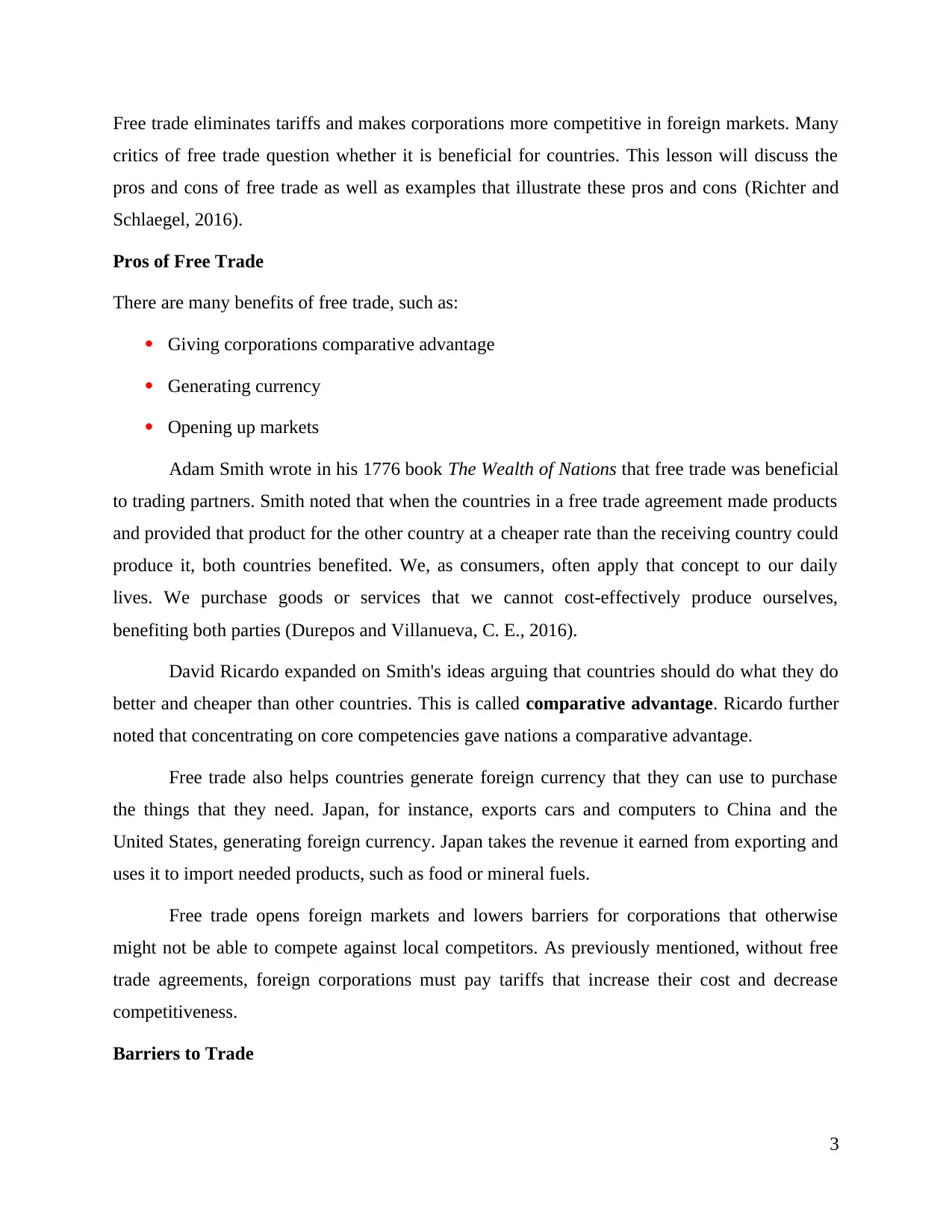
Free trade eliminates tariffs and makes corporations more competitive in foreign markets. Many
critics of free trade question whether it is beneficial for countries. This lesson will discuss the
pros and cons of free trade as well as examples that illustrate these pros and cons (Richter and
Schlaegel, 2016).
Pros of Free Trade
There are many benefits of free trade, such as:
Giving corporations comparative advantage
Generating currency
Opening up markets
Adam Smith wrote in his 1776 book The Wealth of Nations that free trade was beneficial
to trading partners. Smith noted that when the countries in a free trade agreement made products
and provided that product for the other country at a cheaper rate than the receiving country could
produce it, both countries benefited. We, as consumers, often apply that concept to our daily
lives. We purchase goods or services that we cannot cost-effectively produce ourselves,
benefiting both parties (Durepos and Villanueva, C. E., 2016).
David Ricardo expanded on Smith's ideas arguing that countries should do what they do
better and cheaper than other countries. This is called comparative advantage. Ricardo further
noted that concentrating on core competencies gave nations a comparative advantage.
Free trade also helps countries generate foreign currency that they can use to purchase
the things that they need. Japan, for instance, exports cars and computers to China and the
United States, generating foreign currency. Japan takes the revenue it earned from exporting and
uses it to import needed products, such as food or mineral fuels.
Free trade opens foreign markets and lowers barriers for corporations that otherwise
might not be able to compete against local competitors. As previously mentioned, without free
trade agreements, foreign corporations must pay tariffs that increase their cost and decrease
competitiveness.
Barriers to Trade
3
critics of free trade question whether it is beneficial for countries. This lesson will discuss the
pros and cons of free trade as well as examples that illustrate these pros and cons (Richter and
Schlaegel, 2016).
Pros of Free Trade
There are many benefits of free trade, such as:
Giving corporations comparative advantage
Generating currency
Opening up markets
Adam Smith wrote in his 1776 book The Wealth of Nations that free trade was beneficial
to trading partners. Smith noted that when the countries in a free trade agreement made products
and provided that product for the other country at a cheaper rate than the receiving country could
produce it, both countries benefited. We, as consumers, often apply that concept to our daily
lives. We purchase goods or services that we cannot cost-effectively produce ourselves,
benefiting both parties (Durepos and Villanueva, C. E., 2016).
David Ricardo expanded on Smith's ideas arguing that countries should do what they do
better and cheaper than other countries. This is called comparative advantage. Ricardo further
noted that concentrating on core competencies gave nations a comparative advantage.
Free trade also helps countries generate foreign currency that they can use to purchase
the things that they need. Japan, for instance, exports cars and computers to China and the
United States, generating foreign currency. Japan takes the revenue it earned from exporting and
uses it to import needed products, such as food or mineral fuels.
Free trade opens foreign markets and lowers barriers for corporations that otherwise
might not be able to compete against local competitors. As previously mentioned, without free
trade agreements, foreign corporations must pay tariffs that increase their cost and decrease
competitiveness.
Barriers to Trade
3
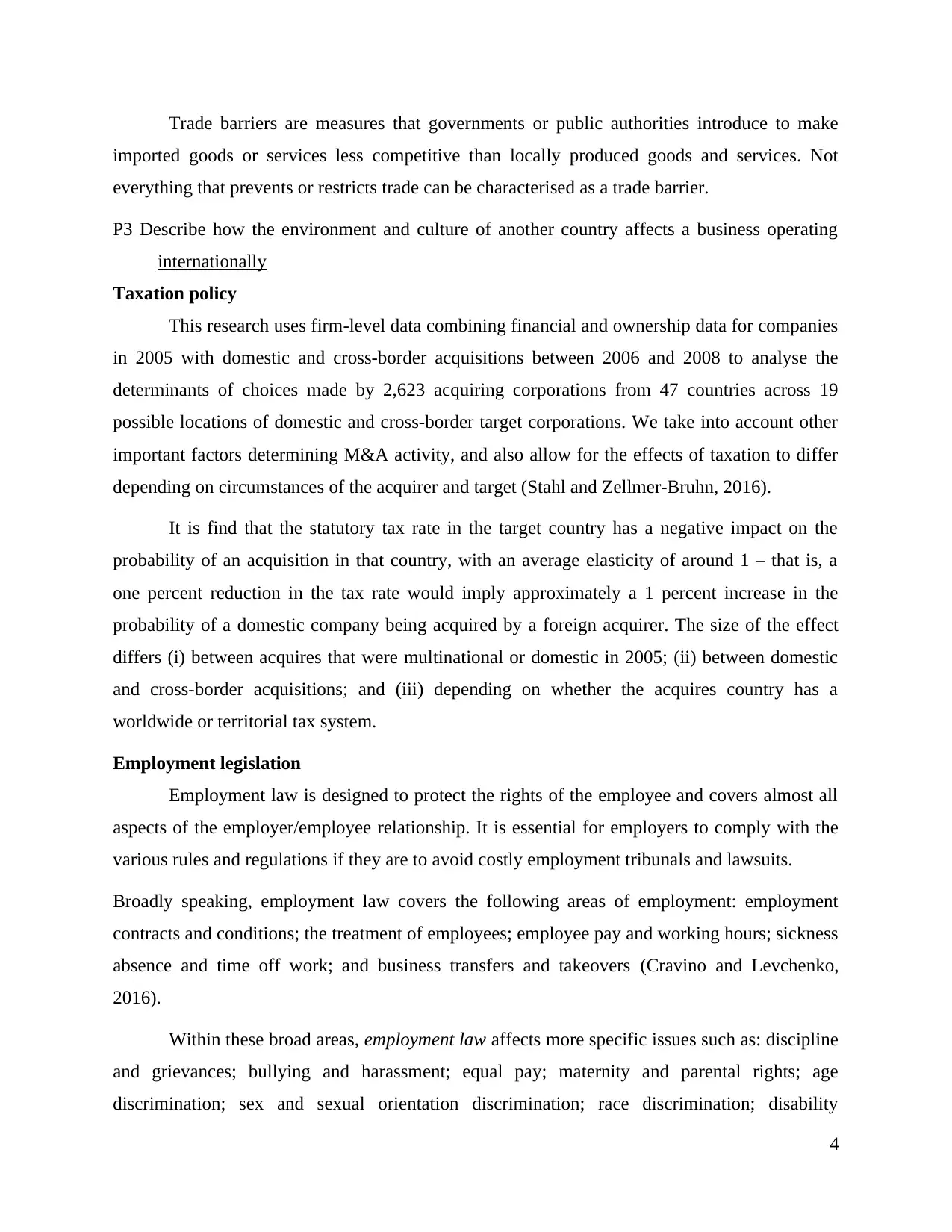
Trade barriers are measures that governments or public authorities introduce to make
imported goods or services less competitive than locally produced goods and services. Not
everything that prevents or restricts trade can be characterised as a trade barrier.
P3 Describe how the environment and culture of another country affects a business operating
internationally
Taxation policy
This research uses firm-level data combining financial and ownership data for companies
in 2005 with domestic and cross-border acquisitions between 2006 and 2008 to analyse the
determinants of choices made by 2,623 acquiring corporations from 47 countries across 19
possible locations of domestic and cross-border target corporations. We take into account other
important factors determining M&A activity, and also allow for the effects of taxation to differ
depending on circumstances of the acquirer and target (Stahl and Zellmer-Bruhn, 2016).
It is find that the statutory tax rate in the target country has a negative impact on the
probability of an acquisition in that country, with an average elasticity of around 1 – that is, a
one percent reduction in the tax rate would imply approximately a 1 percent increase in the
probability of a domestic company being acquired by a foreign acquirer. The size of the effect
differs (i) between acquires that were multinational or domestic in 2005; (ii) between domestic
and cross-border acquisitions; and (iii) depending on whether the acquires country has a
worldwide or territorial tax system.
Employment legislation
Employment law is designed to protect the rights of the employee and covers almost all
aspects of the employer/employee relationship. It is essential for employers to comply with the
various rules and regulations if they are to avoid costly employment tribunals and lawsuits.
Broadly speaking, employment law covers the following areas of employment: employment
contracts and conditions; the treatment of employees; employee pay and working hours; sickness
absence and time off work; and business transfers and takeovers (Cravino and Levchenko,
2016).
Within these broad areas, employment law affects more specific issues such as: discipline
and grievances; bullying and harassment; equal pay; maternity and parental rights; age
discrimination; sex and sexual orientation discrimination; race discrimination; disability
4
imported goods or services less competitive than locally produced goods and services. Not
everything that prevents or restricts trade can be characterised as a trade barrier.
P3 Describe how the environment and culture of another country affects a business operating
internationally
Taxation policy
This research uses firm-level data combining financial and ownership data for companies
in 2005 with domestic and cross-border acquisitions between 2006 and 2008 to analyse the
determinants of choices made by 2,623 acquiring corporations from 47 countries across 19
possible locations of domestic and cross-border target corporations. We take into account other
important factors determining M&A activity, and also allow for the effects of taxation to differ
depending on circumstances of the acquirer and target (Stahl and Zellmer-Bruhn, 2016).
It is find that the statutory tax rate in the target country has a negative impact on the
probability of an acquisition in that country, with an average elasticity of around 1 – that is, a
one percent reduction in the tax rate would imply approximately a 1 percent increase in the
probability of a domestic company being acquired by a foreign acquirer. The size of the effect
differs (i) between acquires that were multinational or domestic in 2005; (ii) between domestic
and cross-border acquisitions; and (iii) depending on whether the acquires country has a
worldwide or territorial tax system.
Employment legislation
Employment law is designed to protect the rights of the employee and covers almost all
aspects of the employer/employee relationship. It is essential for employers to comply with the
various rules and regulations if they are to avoid costly employment tribunals and lawsuits.
Broadly speaking, employment law covers the following areas of employment: employment
contracts and conditions; the treatment of employees; employee pay and working hours; sickness
absence and time off work; and business transfers and takeovers (Cravino and Levchenko,
2016).
Within these broad areas, employment law affects more specific issues such as: discipline
and grievances; bullying and harassment; equal pay; maternity and parental rights; age
discrimination; sex and sexual orientation discrimination; race discrimination; disability
4
⊘ This is a preview!⊘
Do you want full access?
Subscribe today to unlock all pages.

Trusted by 1+ million students worldwide
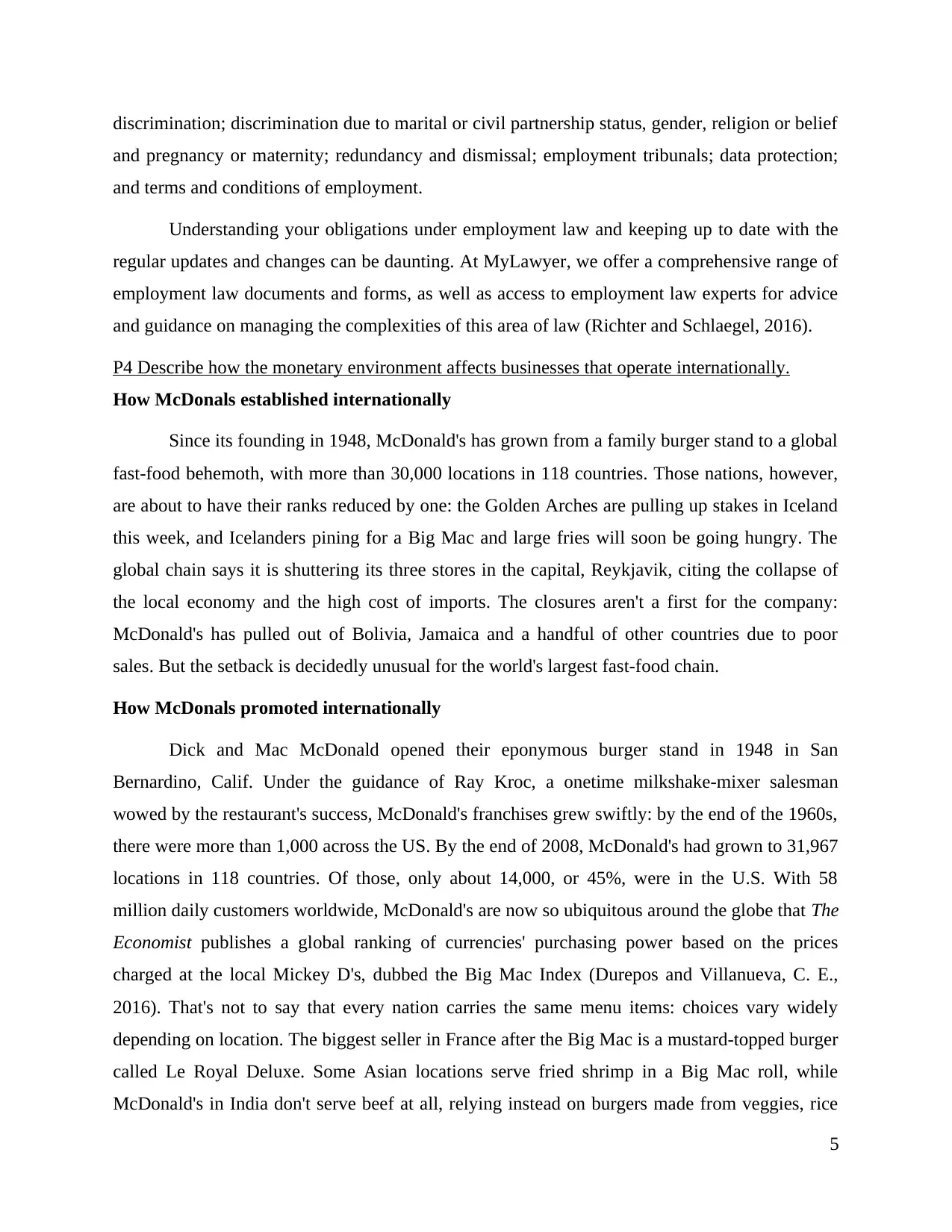
discrimination; discrimination due to marital or civil partnership status, gender, religion or belief
and pregnancy or maternity; redundancy and dismissal; employment tribunals; data protection;
and terms and conditions of employment.
Understanding your obligations under employment law and keeping up to date with the
regular updates and changes can be daunting. At MyLawyer, we offer a comprehensive range of
employment law documents and forms, as well as access to employment law experts for advice
and guidance on managing the complexities of this area of law (Richter and Schlaegel, 2016).
P4 Describe how the monetary environment affects businesses that operate internationally.
How McDonals established internationally
Since its founding in 1948, McDonald's has grown from a family burger stand to a global
fast-food behemoth, with more than 30,000 locations in 118 countries. Those nations, however,
are about to have their ranks reduced by one: the Golden Arches are pulling up stakes in Iceland
this week, and Icelanders pining for a Big Mac and large fries will soon be going hungry. The
global chain says it is shuttering its three stores in the capital, Reykjavik, citing the collapse of
the local economy and the high cost of imports. The closures aren't a first for the company:
McDonald's has pulled out of Bolivia, Jamaica and a handful of other countries due to poor
sales. But the setback is decidedly unusual for the world's largest fast-food chain.
How McDonals promoted internationally
Dick and Mac McDonald opened their eponymous burger stand in 1948 in San
Bernardino, Calif. Under the guidance of Ray Kroc, a onetime milkshake-mixer salesman
wowed by the restaurant's success, McDonald's franchises grew swiftly: by the end of the 1960s,
there were more than 1,000 across the US. By the end of 2008, McDonald's had grown to 31,967
locations in 118 countries. Of those, only about 14,000, or 45%, were in the U.S. With 58
million daily customers worldwide, McDonald's are now so ubiquitous around the globe that The
Economist publishes a global ranking of currencies' purchasing power based on the prices
charged at the local Mickey D's, dubbed the Big Mac Index (Durepos and Villanueva, C. E.,
2016). That's not to say that every nation carries the same menu items: choices vary widely
depending on location. The biggest seller in France after the Big Mac is a mustard-topped burger
called Le Royal Deluxe. Some Asian locations serve fried shrimp in a Big Mac roll, while
McDonald's in India don't serve beef at all, relying instead on burgers made from veggies, rice
5
and pregnancy or maternity; redundancy and dismissal; employment tribunals; data protection;
and terms and conditions of employment.
Understanding your obligations under employment law and keeping up to date with the
regular updates and changes can be daunting. At MyLawyer, we offer a comprehensive range of
employment law documents and forms, as well as access to employment law experts for advice
and guidance on managing the complexities of this area of law (Richter and Schlaegel, 2016).
P4 Describe how the monetary environment affects businesses that operate internationally.
How McDonals established internationally
Since its founding in 1948, McDonald's has grown from a family burger stand to a global
fast-food behemoth, with more than 30,000 locations in 118 countries. Those nations, however,
are about to have their ranks reduced by one: the Golden Arches are pulling up stakes in Iceland
this week, and Icelanders pining for a Big Mac and large fries will soon be going hungry. The
global chain says it is shuttering its three stores in the capital, Reykjavik, citing the collapse of
the local economy and the high cost of imports. The closures aren't a first for the company:
McDonald's has pulled out of Bolivia, Jamaica and a handful of other countries due to poor
sales. But the setback is decidedly unusual for the world's largest fast-food chain.
How McDonals promoted internationally
Dick and Mac McDonald opened their eponymous burger stand in 1948 in San
Bernardino, Calif. Under the guidance of Ray Kroc, a onetime milkshake-mixer salesman
wowed by the restaurant's success, McDonald's franchises grew swiftly: by the end of the 1960s,
there were more than 1,000 across the US. By the end of 2008, McDonald's had grown to 31,967
locations in 118 countries. Of those, only about 14,000, or 45%, were in the U.S. With 58
million daily customers worldwide, McDonald's are now so ubiquitous around the globe that The
Economist publishes a global ranking of currencies' purchasing power based on the prices
charged at the local Mickey D's, dubbed the Big Mac Index (Durepos and Villanueva, C. E.,
2016). That's not to say that every nation carries the same menu items: choices vary widely
depending on location. The biggest seller in France after the Big Mac is a mustard-topped burger
called Le Royal Deluxe. Some Asian locations serve fried shrimp in a Big Mac roll, while
McDonald's in India don't serve beef at all, relying instead on burgers made from veggies, rice
5
Paraphrase This Document
Need a fresh take? Get an instant paraphrase of this document with our AI Paraphraser
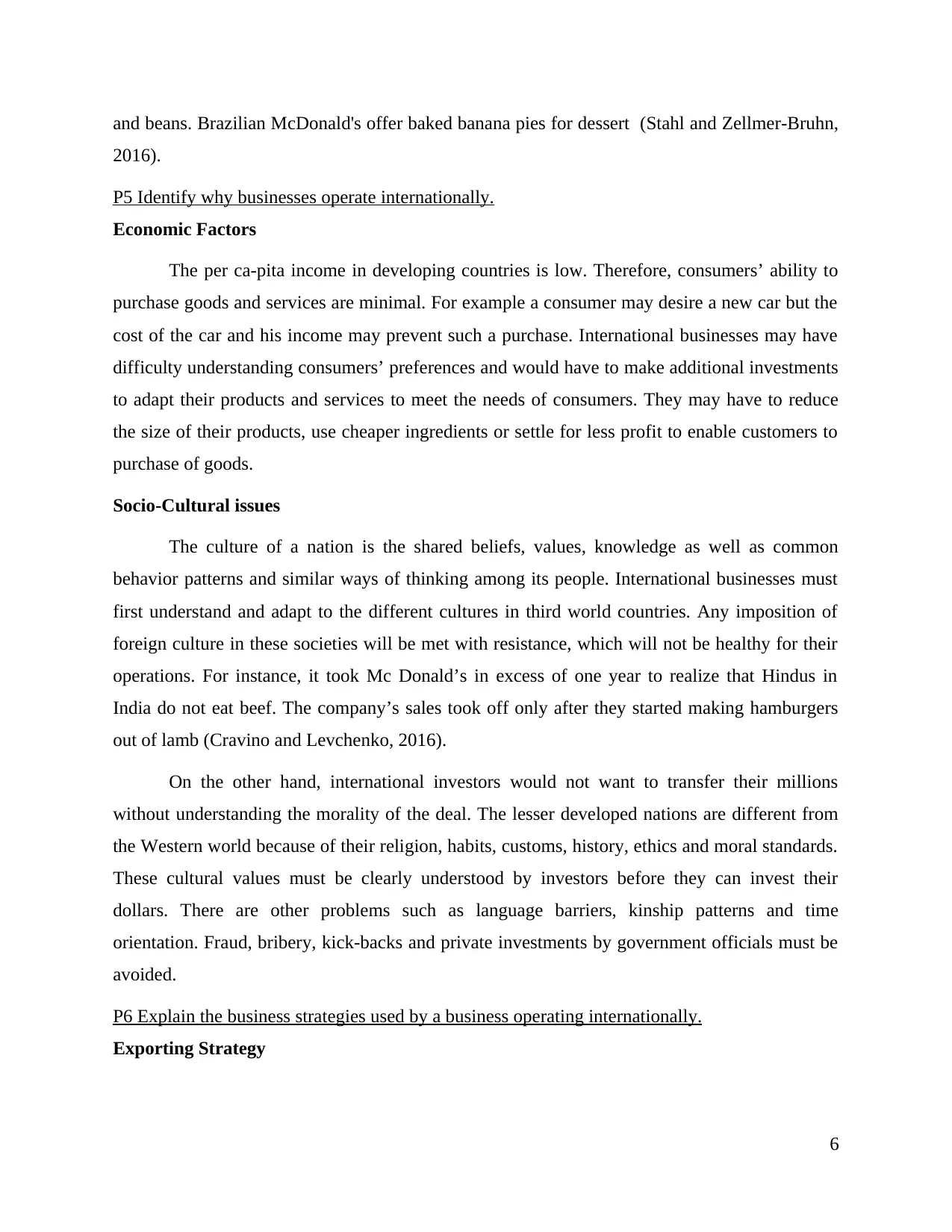
and beans. Brazilian McDonald's offer baked banana pies for dessert (Stahl and Zellmer-Bruhn,
2016).
P5 Identify why businesses operate internationally.
Economic Factors
The per ca-pita income in developing countries is low. Therefore, consumers’ ability to
purchase goods and services are minimal. For example a consumer may desire a new car but the
cost of the car and his income may prevent such a purchase. International businesses may have
difficulty understanding consumers’ preferences and would have to make additional investments
to adapt their products and services to meet the needs of consumers. They may have to reduce
the size of their products, use cheaper ingredients or settle for less profit to enable customers to
purchase of goods.
Socio-Cultural issues
The culture of a nation is the shared beliefs, values, knowledge as well as common
behavior patterns and similar ways of thinking among its people. International businesses must
first understand and adapt to the different cultures in third world countries. Any imposition of
foreign culture in these societies will be met with resistance, which will not be healthy for their
operations. For instance, it took Mc Donald’s in excess of one year to realize that Hindus in
India do not eat beef. The company’s sales took off only after they started making hamburgers
out of lamb (Cravino and Levchenko, 2016).
On the other hand, international investors would not want to transfer their millions
without understanding the morality of the deal. The lesser developed nations are different from
the Western world because of their religion, habits, customs, history, ethics and moral standards.
These cultural values must be clearly understood by investors before they can invest their
dollars. There are other problems such as language barriers, kinship patterns and time
orientation. Fraud, bribery, kick-backs and private investments by government officials must be
avoided.
P6 Explain the business strategies used by a business operating internationally.
Exporting Strategy
6
2016).
P5 Identify why businesses operate internationally.
Economic Factors
The per ca-pita income in developing countries is low. Therefore, consumers’ ability to
purchase goods and services are minimal. For example a consumer may desire a new car but the
cost of the car and his income may prevent such a purchase. International businesses may have
difficulty understanding consumers’ preferences and would have to make additional investments
to adapt their products and services to meet the needs of consumers. They may have to reduce
the size of their products, use cheaper ingredients or settle for less profit to enable customers to
purchase of goods.
Socio-Cultural issues
The culture of a nation is the shared beliefs, values, knowledge as well as common
behavior patterns and similar ways of thinking among its people. International businesses must
first understand and adapt to the different cultures in third world countries. Any imposition of
foreign culture in these societies will be met with resistance, which will not be healthy for their
operations. For instance, it took Mc Donald’s in excess of one year to realize that Hindus in
India do not eat beef. The company’s sales took off only after they started making hamburgers
out of lamb (Cravino and Levchenko, 2016).
On the other hand, international investors would not want to transfer their millions
without understanding the morality of the deal. The lesser developed nations are different from
the Western world because of their religion, habits, customs, history, ethics and moral standards.
These cultural values must be clearly understood by investors before they can invest their
dollars. There are other problems such as language barriers, kinship patterns and time
orientation. Fraud, bribery, kick-backs and private investments by government officials must be
avoided.
P6 Explain the business strategies used by a business operating internationally.
Exporting Strategy
6
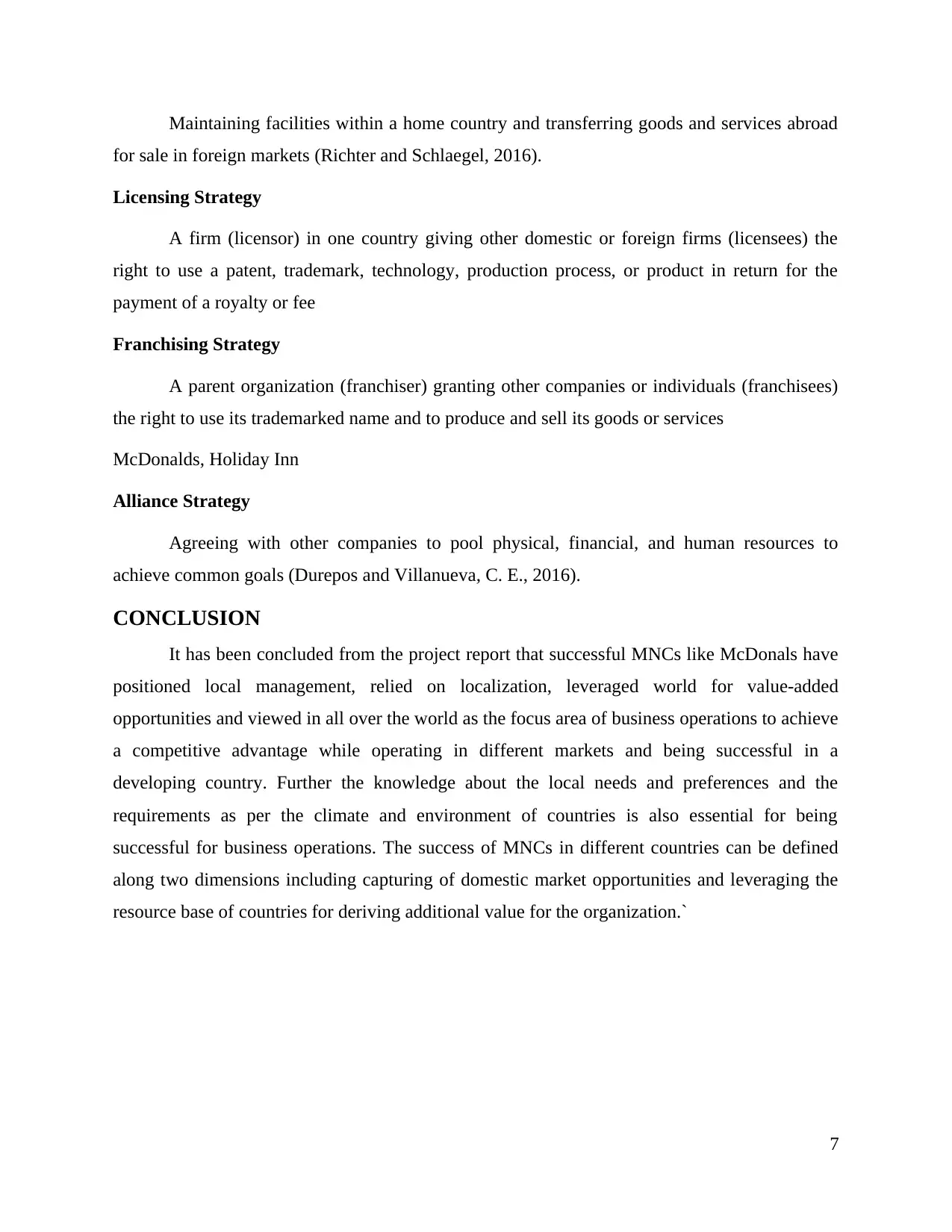
Maintaining facilities within a home country and transferring goods and services abroad
for sale in foreign markets (Richter and Schlaegel, 2016).
Licensing Strategy
A firm (licensor) in one country giving other domestic or foreign firms (licensees) the
right to use a patent, trademark, technology, production process, or product in return for the
payment of a royalty or fee
Franchising Strategy
A parent organization (franchiser) granting other companies or individuals (franchisees)
the right to use its trademarked name and to produce and sell its goods or services
McDonalds, Holiday Inn
Alliance Strategy
Agreeing with other companies to pool physical, financial, and human resources to
achieve common goals (Durepos and Villanueva, C. E., 2016).
CONCLUSION
It has been concluded from the project report that successful MNCs like McDonals have
positioned local management, relied on localization, leveraged world for value-added
opportunities and viewed in all over the world as the focus area of business operations to achieve
a competitive advantage while operating in different markets and being successful in a
developing country. Further the knowledge about the local needs and preferences and the
requirements as per the climate and environment of countries is also essential for being
successful for business operations. The success of MNCs in different countries can be defined
along two dimensions including capturing of domestic market opportunities and leveraging the
resource base of countries for deriving additional value for the organization.`
7
for sale in foreign markets (Richter and Schlaegel, 2016).
Licensing Strategy
A firm (licensor) in one country giving other domestic or foreign firms (licensees) the
right to use a patent, trademark, technology, production process, or product in return for the
payment of a royalty or fee
Franchising Strategy
A parent organization (franchiser) granting other companies or individuals (franchisees)
the right to use its trademarked name and to produce and sell its goods or services
McDonalds, Holiday Inn
Alliance Strategy
Agreeing with other companies to pool physical, financial, and human resources to
achieve common goals (Durepos and Villanueva, C. E., 2016).
CONCLUSION
It has been concluded from the project report that successful MNCs like McDonals have
positioned local management, relied on localization, leveraged world for value-added
opportunities and viewed in all over the world as the focus area of business operations to achieve
a competitive advantage while operating in different markets and being successful in a
developing country. Further the knowledge about the local needs and preferences and the
requirements as per the climate and environment of countries is also essential for being
successful for business operations. The success of MNCs in different countries can be defined
along two dimensions including capturing of domestic market opportunities and leveraging the
resource base of countries for deriving additional value for the organization.`
7
⊘ This is a preview!⊘
Do you want full access?
Subscribe today to unlock all pages.

Trusted by 1+ million students worldwide
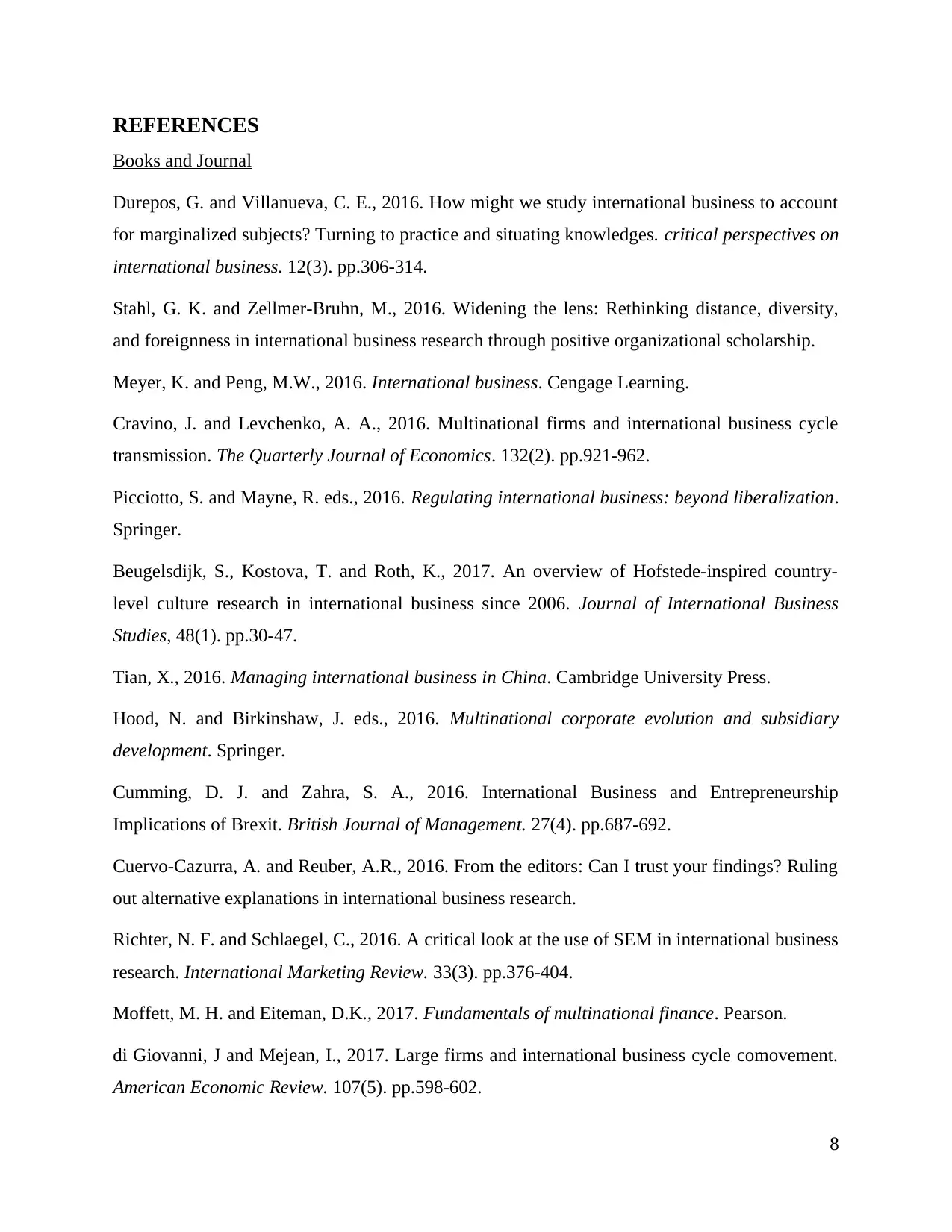
REFERENCES
Books and Journal
Durepos, G. and Villanueva, C. E., 2016. How might we study international business to account
for marginalized subjects? Turning to practice and situating knowledges. critical perspectives on
international business. 12(3). pp.306-314.
Stahl, G. K. and Zellmer-Bruhn, M., 2016. Widening the lens: Rethinking distance, diversity,
and foreignness in international business research through positive organizational scholarship.
Meyer, K. and Peng, M.W., 2016. International business. Cengage Learning.
Cravino, J. and Levchenko, A. A., 2016. Multinational firms and international business cycle
transmission. The Quarterly Journal of Economics. 132(2). pp.921-962.
Picciotto, S. and Mayne, R. eds., 2016. Regulating international business: beyond liberalization.
Springer.
Beugelsdijk, S., Kostova, T. and Roth, K., 2017. An overview of Hofstede-inspired country-
level culture research in international business since 2006. Journal of International Business
Studies, 48(1). pp.30-47.
Tian, X., 2016. Managing international business in China. Cambridge University Press.
Hood, N. and Birkinshaw, J. eds., 2016. Multinational corporate evolution and subsidiary
development. Springer.
Cumming, D. J. and Zahra, S. A., 2016. International Business and Entrepreneurship
Implications of Brexit. British Journal of Management. 27(4). pp.687-692.
Cuervo-Cazurra, A. and Reuber, A.R., 2016. From the editors: Can I trust your findings? Ruling
out alternative explanations in international business research.
Richter, N. F. and Schlaegel, C., 2016. A critical look at the use of SEM in international business
research. International Marketing Review. 33(3). pp.376-404.
Moffett, M. H. and Eiteman, D.K., 2017. Fundamentals of multinational finance. Pearson.
di Giovanni, J and Mejean, I., 2017. Large firms and international business cycle comovement.
American Economic Review. 107(5). pp.598-602.
8
Books and Journal
Durepos, G. and Villanueva, C. E., 2016. How might we study international business to account
for marginalized subjects? Turning to practice and situating knowledges. critical perspectives on
international business. 12(3). pp.306-314.
Stahl, G. K. and Zellmer-Bruhn, M., 2016. Widening the lens: Rethinking distance, diversity,
and foreignness in international business research through positive organizational scholarship.
Meyer, K. and Peng, M.W., 2016. International business. Cengage Learning.
Cravino, J. and Levchenko, A. A., 2016. Multinational firms and international business cycle
transmission. The Quarterly Journal of Economics. 132(2). pp.921-962.
Picciotto, S. and Mayne, R. eds., 2016. Regulating international business: beyond liberalization.
Springer.
Beugelsdijk, S., Kostova, T. and Roth, K., 2017. An overview of Hofstede-inspired country-
level culture research in international business since 2006. Journal of International Business
Studies, 48(1). pp.30-47.
Tian, X., 2016. Managing international business in China. Cambridge University Press.
Hood, N. and Birkinshaw, J. eds., 2016. Multinational corporate evolution and subsidiary
development. Springer.
Cumming, D. J. and Zahra, S. A., 2016. International Business and Entrepreneurship
Implications of Brexit. British Journal of Management. 27(4). pp.687-692.
Cuervo-Cazurra, A. and Reuber, A.R., 2016. From the editors: Can I trust your findings? Ruling
out alternative explanations in international business research.
Richter, N. F. and Schlaegel, C., 2016. A critical look at the use of SEM in international business
research. International Marketing Review. 33(3). pp.376-404.
Moffett, M. H. and Eiteman, D.K., 2017. Fundamentals of multinational finance. Pearson.
di Giovanni, J and Mejean, I., 2017. Large firms and international business cycle comovement.
American Economic Review. 107(5). pp.598-602.
8
Paraphrase This Document
Need a fresh take? Get an instant paraphrase of this document with our AI Paraphraser
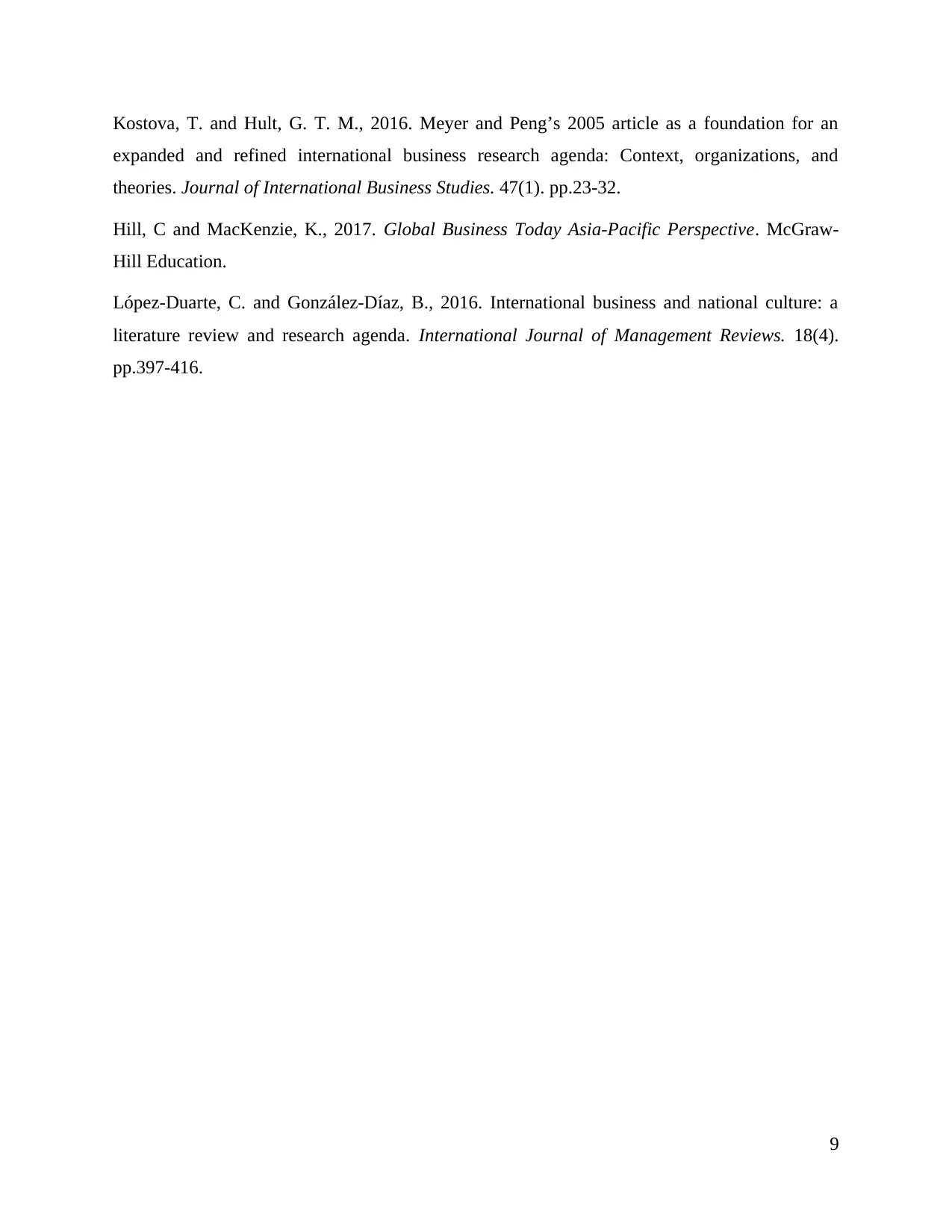
Kostova, T. and Hult, G. T. M., 2016. Meyer and Peng’s 2005 article as a foundation for an
expanded and refined international business research agenda: Context, organizations, and
theories. Journal of International Business Studies. 47(1). pp.23-32.
Hill, C and MacKenzie, K., 2017. Global Business Today Asia-Pacific Perspective. McGraw-
Hill Education.
López‐Duarte, C. and González‐Díaz, B., 2016. International business and national culture: a
literature review and research agenda. International Journal of Management Reviews. 18(4).
pp.397-416.
9
expanded and refined international business research agenda: Context, organizations, and
theories. Journal of International Business Studies. 47(1). pp.23-32.
Hill, C and MacKenzie, K., 2017. Global Business Today Asia-Pacific Perspective. McGraw-
Hill Education.
López‐Duarte, C. and González‐Díaz, B., 2016. International business and national culture: a
literature review and research agenda. International Journal of Management Reviews. 18(4).
pp.397-416.
9
1 out of 11
Related Documents
Your All-in-One AI-Powered Toolkit for Academic Success.
+13062052269
info@desklib.com
Available 24*7 on WhatsApp / Email
![[object Object]](/_next/static/media/star-bottom.7253800d.svg)
Unlock your academic potential
Copyright © 2020–2025 A2Z Services. All Rights Reserved. Developed and managed by ZUCOL.




